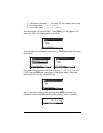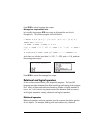
Page 21-36
Example 3 – tagging input and output from function p(V,T)
In this example we modify the program @@@p@@@ so that the output tagged input
values and tagged result. Use ‚@@@p@@@ to recall the contents of the program to
the stack:
« “Enter V, T, and n:“ {“ :V: :T: :n:“ {2 0} V } INPUT
OBJ→→ V T n ‘(8.31451_J/(K*mol))*(n*T/V)‘ »
Modify it to read:
« “Enter V, T and n: “ {“ :V: :T: :n:“ {2 0} V } INPUT
OBJ→→ V T n
« V T n ‘(8.31451_J/(K*mol))*(n*T/V)‘ EVAL “p”
→TAG »»
Note: Notice that we have placed the calculation and tagging of the function
p(V,T,n), preceded by a recall of the input variables V T n, into a sub-program
[the sequence of instructions contained within the inner set of program symbols
« » ]. This is necessary because without the program symbol separating the
two listings of input variables (V T N
« V T n), the program will assume that
the input command
→ V T N V T n
requires six input values, while only three are available. The result would have
been the generation of an error message and the interruption of the program
execution.
To include the subprogram mentioned above in the modified definition of
program @@@p@@@, will require you to use ‚å at the beginning and end of the
sub-program. Because the program symbols occur in pairs, whenever ‚å
is invoked, you will need to erase the closing program symbol (») at the
beginning, and the opening program symbol (
«) at the end, of the sub-program.
To erase any character while editing the program, place the cursor to the right
of the character to be erased and use the backspace key ƒ.


















